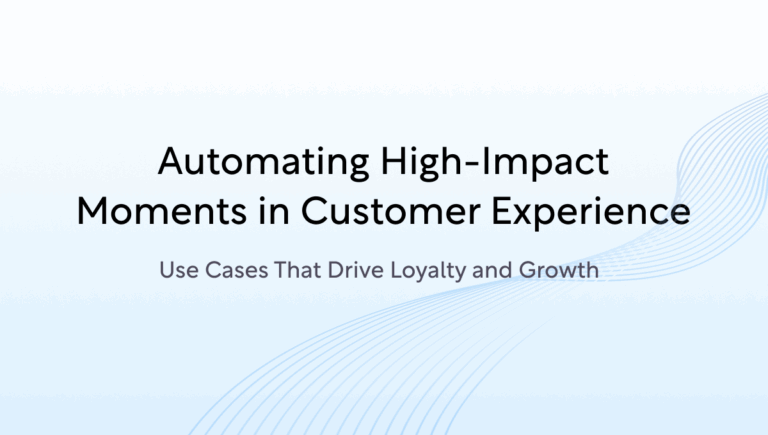In today’s competitive landscape, customer experience (CX) is often defined by how well an organization handles the moments that carry the most weight—those that shape a customer’s perception, trust, and decision to stay or leave. These aren’t always dramatic events. Sometimes, it’s the smooth onboarding after signup, the swift resolution of an issue, or a well-timed check-in before a renewal.
The common thread? Timeliness, relevance, and consistency. And that’s where process automation comes in.
Why the Right Moment Matters More Than More Moments
Not all interactions need to be exceptional—but the right ones do. High-impact CX moments often happen when:
- A new customer is navigating your product for the first time
- A support issue disrupts business-critical operations
- A renewal decision is approaching, and usage is lagging
- Feedback is submitted and left unanswered
These moments, while infrequent, are loaded with opportunity—or risk. The quality of response can deepen the relationship or degrade it.
Automating for Impact: CX Use Cases that Deliver Results
Here are some of the most valuable areas where automation consistently improves customer experience outcomes:
1. Onboarding with Confidence and Clarity
The experience immediately after signup can make or break the relationship. Customers expect instant value, not a waiting game.
Example workflow:
- Trigger a welcome email with a personalized checklist
- Launch a guided product tour based on the user’s role or industry
- Monitor engagement in the first 24 hours—if low, prompt a helpful nudge
- Escalate to a CSM if inactivity persists for 48 hours
Result: Faster time-to-value, reduced churn during early lifecycle, and more confident users.
2. Proactive Support, Not Just Reactive
Support should feel seamless—especially when something goes wrong. Automating the path from issue to resolution creates trust.
Example workflow:
- When a P1 ticket is submitted, immediately notify the appropriate team via Slack or Teams
- Auto-assign based on expertise and availability
- Trigger a personalized update to the customer within 15 minutes
- Send a follow-up survey, and route poor Customer Satisfaction Scores (CSAT) directly to management
Result: Faster resolution, better sentiment recovery, and a culture of accountability.
3. Health Monitoring and Retention Interventions
A drop in usage is one of the earliest signs of disengagement—but without automation, it’s easy to miss.
Example workflow:
- Monitor login frequency, feature usage, and support ticket volume
- If activity falls below baseline, trigger a CSM alert with suggested playbooks
- Launch a re-engagement email sequence
- If no improvement after 7 days, schedule a strategic review
Result: Reduced preventable churn and better alignment with customer needs.
4. Renewals: Start Early, Come Prepared
Renewals aren’t just commercial milestones—they’re tests of long-term value. And they should never feel like surprises.
Example workflow:
- 90 days before renewal, trigger usage summary emails with key metrics
- If value indicators are strong, start upsell/expansion journey
- If indicators are weak, flag for renewal risk and engage the CSM
- Automate quote generation and contract routing when ready
Result: Higher renewal rates, more confident decisions, and stronger customer alignment.
📍Real-World Example: ProcessMaker for Real Estate
One leading Nordic real estate company faced visibility challenges across its fragmented IT landscape and customer service workflows. With over 7,500 monthly service requests and dozens of legacy CRMs, the company struggled to pinpoint where time was being spent and which requests were automatable. After analyzing the existing workflows with ProcessMaker, they automated some of their processes, decreasing time to resolution from days to minutes. They also uncovered revenue leakage due to unbilled out-of-scope requests.
Smoother Journeys, Scalable Relationships
Automated workflows reduce friction—not just for customers, but also for the teams supporting them. By removing manual delays, reducing inconsistencies, and enabling timely action, businesses can scale high-touch experiences without scaling headcount.
Whether it’s through intelligent routing, real-time alerts, or dynamic content delivery, automation brings structure to what could otherwise be chaos.
The Takeaway: Be Ready When It Counts
The best customer experiences aren’t created from a thousand small gestures—they’re defined by how well you respond when it truly counts. Automating your workflows around those key inflection points ensures that nothing is missed, delayed, or left to chance.
At ProcessMaker, we help businesses turn their CX vision into reality through process automation built for precision and responsiveness. Whether you’re managing onboarding, support, renewals, or retention, our workflows are designed to show up exactly when you and your customers need them most.
FAQs:
What is customer experience (CX) automation?
Customer experience automation uses workflows, triggers, and rules to streamline and personalize customer interactions across the journey. It ensures timely, relevant, and consistent engagement—without requiring manual intervention.
Why automate parts of the customer journey?
Automation helps reduce response times, increase consistency, and improve customer satisfaction by proactively handling key touchpoints like onboarding, support, renewals, and feedback loops.
What are high-impact moments in the customer journey?
High-impact moments in CX are onboarding, critical support issues, renewal decisions, or inactivity signals.
How do you automate customer onboarding?
Customer onboarding can be automated through workflows that send welcome emails, launch product tours, track engagement, and trigger reminders or CSM outreach based on user behavior within the first 24–48 hours.
What tools are used for CX workflow automation?
Popular tools for CX workflow automation include platforms like ProcessMaker—often integrated with CRMs, analytics, and communication tools.
Can automation improve customer retention?
Yes. Automated workflows help detect churn signals early, personalize engagement, and keep customers active—leading to higher retention and lifetime value.
What’s an example of a customer experience automation workflow?
An onboarding workflow might trigger a welcome email at signup, monitor activation behavior, and escalate to a human touchpoint if no engagement occurs within 24 hours.
Does automation replace human interaction in CX?
No. Automation supports human interaction by handling routine tasks and ensuring critical moments are addressed quickly and with context—freeing teams to focus on high-value conversations.


